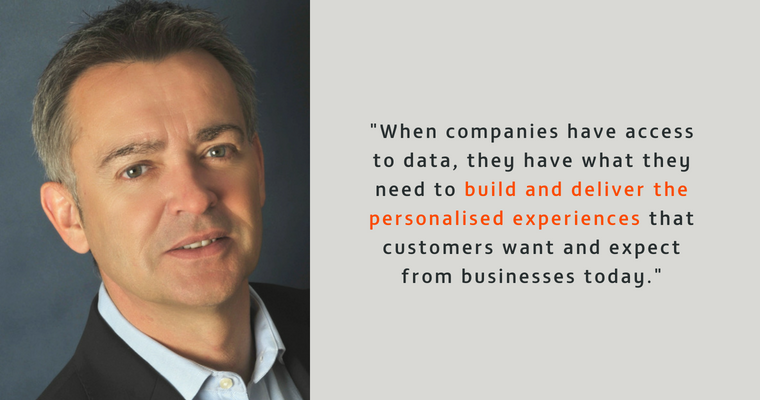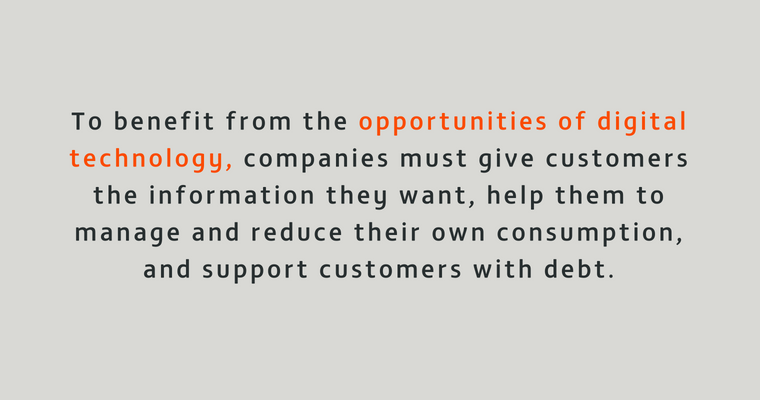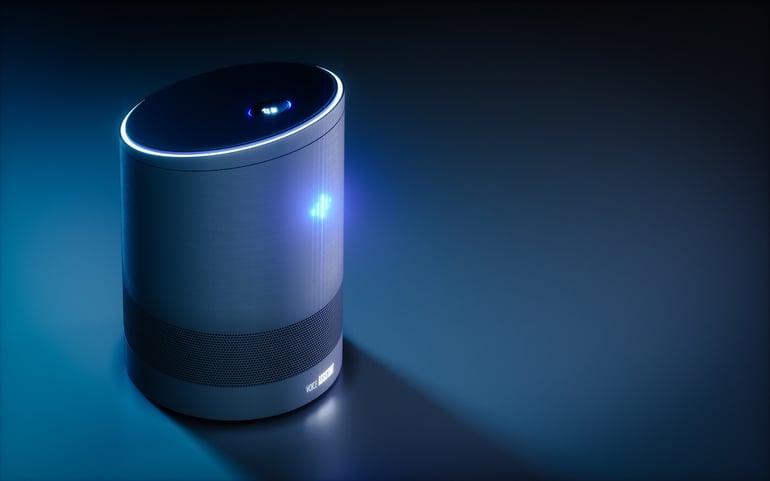Have utilities companies missed the boat when it comes to data driven customer experiences?
Written by Robyn Jones
With a strong focus on how organisations can improve performance through digital strategies and technologies, we wanted to hear Paul’s thoughts on the role of data and how it can elevate customer experience.
 Where do you think the greatest opportunities lie for utility companies, in terms of using digital to improve the customer experience?
Where do you think the greatest opportunities lie for utility companies, in terms of using digital to improve the customer experience?
There are a lot of opportunities for utilities companies looking to harness digital, but it comes down to the organisation’s primary drivers and the goals of their strategy.
It’s not just about marketing, it’s about improving communication between businesses and their customers, and reducing operational costs at the same time.
If you think about this from the perspective of a water authority, for example. At the very basic level, they want to properly treat wastewater, provide their customers with cleanliness of water, and ensure continuity of supply.
These are the minimum expectations of customers.
Historically, this is what companies have measured their success against - the performance of their infrastructure, i.e. their pipes, reservoirs, and their supply of water to customers in both the B2B and B2C market.
But there is a shift happening, and customers are demanding much more from their water suppliers. Which of course presents key opportunities, and challenges, for utility companies.
Access to information
Here we’re talking about things like help desk support, optimising the use of water, reducing and monitoring consumption, monitoring costs, and having access to much more information about all of this, so that they can manage their consumption and, ultimately, conserve supply and save costs.
Ofwat are playing a significant part in driving this change across water companies. Their most recent price review, PR19, calls on water companies to ensure customers are active participants in the service that they provide.
It’s changing how businesses measure success, and now they are beginning to focus on the other services they provide, as well as how they can optimise their customers’ digital interactions with each arm of the business.
Help with debt management
Utilities, especially water, are an essential ingredient for every household. So it’s unfair, unreasonable and unethical to cut customers off from water, just because they can’t pay the bill.
One way to help customers manage finances and make payments is by preparing them for the costs of future bills, showing them how much they’re likely to consume and clearly explaining what their bills will look like because of this.
By harnessing the different digital channels available, businesses can deliver this information more effectively. More so, they can use data to identify where customers want to see this information, and make sure it’s there - apps, social media, customer accounts, and so on.
Lower costs
Price plays a big part in the satisfaction of any company’s customer experience.
And putting together a digital strategy can help drive down costs which is a win for both the customer and the supplier.
For example, many companies currently invest a lot of money and resource into call centres. And this is how customers access a lot of the information they want and need, such as reporting issues with their supply, asking questions about their bills, or enquiring into quality problems etc.
Moving this online, and giving people access to all of this information through a digital property, will help keep customers happier and more informed, while driving down operational costs.

You’ve used the water industry as an example there. Do these same principles apply to other utilities companies as well?
Yes, these principles can be applied equally, if not more, to other utilities companies.
At the moment, people have a choice when it comes to their gas and electric suppliers. These organisations have to be more switched on when it comes to these principles, or they will lose out on business.
It’s not quite the same for water, in the B2C market anyway, because people can’t currently pick and choose their supplier.
So actually, you could suggest that there’s more pressure on utilities companies outside of water to really harness the opportunities of digital transformation.
Where are the biggest challenges for companies in realising these opportunities?
I think the biggest challenge is getting the board of directors to really understand and buy in to the potential that digital marketing communications can bring to the business.
In general, utilities is a traditional and conservative industry, and digital transformation is the opposite. So there has to be an education and, sometimes, a shift in mindset, around the opportunities that lie in digital.
Without education, and without sponsorship from the executive team, companies are going to end up using digital channels in a misguided, uninnovative and at best, a tactical way.
Another issue is technology. Updating the way large organisations integrate digital into their systems to help provide an omni-channel experience is always a challenge, regardless of sector. It’s a transformational process that requires businesses to refresh legacy technologies and adopt a new approach that they might not be accustomed to.
For it to work, different functions within an organisation need to unite; customer services might need to work with supply, billing, management, people out there in the field etc.
But breaking down these silos means there is a justification for replacing legacy systems which are no longer fit for purpose.
The third vital challenge is return on investment (ROI). I don’t think that financial directors in utility companies are being provided with the right information from their digital teams, in regards to what the actual ROI is going to be.
Marketers, communications specialists and/or digital teams need to be able to provide directors, particularly CSOs, with a strong and accurate business case for the transformation. The ROI in monetary terms.
How can customer experience platforms enable organisations to harness these opportunities?
Customer experience platforms enable organisations to interact with customers in a real time, interactive, and omni-channel way. They also allow companies to personalise experiences to the individual, depending on where they are, what they’re doing, and what device they are on.
So in a sense, the right platform can help businesses create a much better customer experience on the whole. The customer can be given access to the information they want, and where they want it, while businesses can improve their service at a lower cost.
For example, every company has certain service scores they have to meet. For water companies, this is SIM Scores (Service Incentive Mechanism) - soon to be C-MeX with PR19. Companies have to remove drivers of dissatisfaction, like not having instant access to accurate and real time billing information, and create a more resilient service to improve these scores.
This is where platforms like Sitecore come in.
For companies to benefit from the opportunities of digital, they need to give customers the information they want, what is relevant to them, to help and encourage customers to manage and reduce consumption, support customers with debt, and reduce costs. Companies have to know everything there is to know about their customers.
Knowing your customers underpins the capability to provide an improved customer experience and boost service scores.
Companies might know customers’ postcodes and past consumption, but that’s about it. Customer experience platforms and digital agencies can change this though. They can harvest all sorts of digital interactions and information, transaction information, and build demographic and psychographic profiles of the consumers.

With access to all of this information, companies are in a much better position to personalise and tailor content to each of their customers. And organisations can go back and refer to this data if they hold it all in one place, like Sitecore’s Experience Database.
Things like automated personalisation make it really easy to streamline the customer journey so that it provides the information the customer wants, when they want it, and how they want. Once a business knows their customers’ journeys, they can determine which technologies and processes will effectively optimise them.
And how can companies ensure that they are using data effectively, to improve their customer experience?
Even the basic things make a significant difference to a customer’s experience with a company.
For example, every utility company has access to GeoIP (the geographic location of a person’s computer) - so if and when there’s a flood warning or water quality issue, they can use simple data, like location, to deliver messages and information to people who live in that area.
To get the most out of their data, businesses need to do two things:
- Collect digital data in the first instance. Companies aren’t doing this - they don’t know the monetary value, demographic, psychographic profile of anyone who interacts with them online.
- Remove data silos. Each system - billing systems, email systems, CLN systems, website systems - has their own data silos. But these need to be put into one central location and managed holistically.
When companies have access to data, they have what they need to build and deliver the personalised experiences that customers want and expect from all businesses today.
And that’s key.
You just have to look at other sectors to see that utilities is lagging behind. The industry is serving businesses and serving consumers, but they’re not really following the progression of say, the retail market.
Companies also have to ready for GDPR, and the impact of that. They need to have a security strategy in place.
Are there any key lessons that utility companies can learn from other companies/sectors about how data can improve customer experience?
They can learn a lot from businesses who are capturing data on their customers, and engaging with them in an omni-channel sense.
Companies like Amazon are engaging with their customers through sales support, they are moving rapidly towards omni-channel, and they are taking advantage of personalisation. I think this is what utility companies need to be doing…
Utility suppliers can certainly take advantage of mobile apps, email, search engines, and even when people in the field visit properties. If they want to keep pace with customer expectations, they need to be communicating, engaging and interacting through different channels.
Another key lesson they can learn from other companies, and indeed other sectors, is how to build and nurture deeper connections and relationships with customers that help to preempt customer behaviour.
There’s a lot to be gained from helping consumers manage and reduce their own consumption. If a water company knows there is a drought coming to a particular area, they can let customers know based on their location.
But it’s also an opportunity for businesses to cross sell, because we’re seeing more and more suppliers offering additional products and services.
For example, most water companies are now offer water saving devices, like water butts and water collection products. If they have collected data that says ‘this customer has a garden’, the should be recognising the opportunity to sell these additional products with the incentive that customers are going to save water and reduce bills.
And then there’s personalisation. Organisations need to be creative about the way they get consumer advocacy, by proving to customers that they are receiving the best package and price based on their own personal patterns of consumption and behaviours. They can achieve this through technologies like mobile apps, or even Internet of Things (IoT) which connects physical devices and allows them to exchange data.
The most common use of IoT in utilities is the use of smart meters, which empower customers to manage the amount of energy they are consuming on a day to day basis. Of course it goes above and beyond this…

Take a home that has previously had a fault or water leak from a pipe. By installing an appliance with IoT sensors, organisations can monitor and assess the health of the pipes to help foresee and avoid future problems. Access to this type of data, in real-time, means companies can be proactive about the service their customer needs, and deliver relevant and helpful information to them when they need it.
To take it one step further, businesses should also be looking at ways they can add extra value. For example, utilities providers could create branded skills for one of Google’s or Amazon’s home assistants, so customers have 24/7 support from inside their own home. They could then install these assistants in their customers’ homes for free, to demonstrate value and encourage advocacy.
Ultimately, I think utilities companies need to focus on capturing the right data on each of their customers, and find a way to build deeper connections through this information. A lot of this will come down to being able to deliver the right information, at the right time, through the right channel.

What else is going on
-
March 2024
Ghost Spam in GA4 – How to Spot and Deal With It
How to spot and deal with ghost spam in Google Analytics 4 (GA4) to safeguard your data insights. Implement proactive measures to maintain data accuracy.
-
November 2023
Mando to bridge skills gap at BIMA Digital Day
The BIMA Digital Day on November 8th is an attempt to bridge this skills gap, as eight of Mando's experts will spend time with around 240 Year 10 students from The Studio School at their Liverpool campus.

